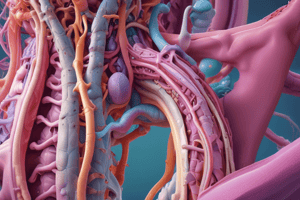Podcast
Questions and Answers
What is the path of the preganglionic fiber after leaving the anterior ramus of the spinal nerve through the white ramus communicans?
What is the path of the preganglionic fiber after leaving the anterior ramus of the spinal nerve through the white ramus communicans?
The preganglionic fiber enters the sympathetic trunk, passes through it, and then enters the greater splanchnic nerve.
Where does the greater splanchnic nerve terminate, and what occurs at this location?
Where does the greater splanchnic nerve terminate, and what occurs at this location?
The greater splanchnic nerve passes through the crura of the diaphragm and enters the celiac ganglion, where the preganglionic fiber synapses with the postganglionic neuron.
Describe the path of the parasympathetic innervation to the abdominal organs.
Describe the path of the parasympathetic innervation to the abdominal organs.
The parasympathetic innervation to the abdominal organs comes from the vagus nerves, which enter the abdomen as the anterior and posterior vagal trunks and send branches to the abdominal prevertebral plexus. These branches contain preganglionic parasympathetic fibers and visceral afferent fibers, which are distributed along the branches of the abdominal aorta.
What is the role of the enteric nervous system in the gastrointestinal tract, and how does the sympathetic system modify its activities?
What is the role of the enteric nervous system in the gastrointestinal tract, and how does the sympathetic system modify its activities?
Explain the significance of the white ramus communicans in the sympathetic innervation pathway.
Explain the significance of the white ramus communicans in the sympathetic innervation pathway.
What is the function of the celiac ganglion in the sympathetic innervation of the gastrointestinal tract?
What is the function of the celiac ganglion in the sympathetic innervation of the gastrointestinal tract?
What is the primary pathway for detecting and transmitting esophageal pain to the CNS?
What is the primary pathway for detecting and transmitting esophageal pain to the CNS?
Describe the path of the vagus nerve fibers as they approach and innervate the esophagus.
Describe the path of the vagus nerve fibers as they approach and innervate the esophagus.
What structures pass through the esophageal hiatus along with the esophagus?
What structures pass through the esophageal hiatus along with the esophagus?
How do the sympathetic and parasympathetic innervations of the esophagus differ in their pathways?
How do the sympathetic and parasympathetic innervations of the esophagus differ in their pathways?
What is the role of the white ramus communicans in the innervation of the esophagus?
What is the role of the white ramus communicans in the innervation of the esophagus?
How does the enteric nervous system relate to the innervation pathways described for the esophagus?
How does the enteric nervous system relate to the innervation pathways described for the esophagus?
Describe the pathway of sympathetic innervation to the stomach, starting from the spinal cord level.
Describe the pathway of sympathetic innervation to the stomach, starting from the spinal cord level.
What is the role of the white ramus communicans in sympathetic innervation to the stomach?
What is the role of the white ramus communicans in sympathetic innervation to the stomach?
How does the parasympathetic innervation to the stomach differ from the sympathetic innervation pathway?
How does the parasympathetic innervation to the stomach differ from the sympathetic innervation pathway?
What is the role of the greater splanchnic nerve in sympathetic innervation to the stomach?
What is the role of the greater splanchnic nerve in sympathetic innervation to the stomach?
Describe the components and functions of the enteric nervous system in the stomach.
Describe the components and functions of the enteric nervous system in the stomach.
How does the enteric nervous system interact with the central nervous system (CNS) in regulating stomach function?
How does the enteric nervous system interact with the central nervous system (CNS) in regulating stomach function?
Flashcards are hidden until you start studying



